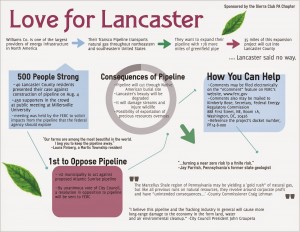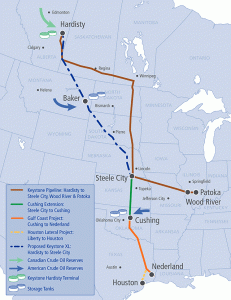Social Context
The social context of the pipeline proposal is best explained through the history of energy production in Pennsylvania and the environmental implications of the pipeline. Pennsylvania has a deep and long lasting legacy of energy production. The history of energy production in Pennsylvania dates back to over 200 years ago when coal mining began in Pennsylvania (Energy Information Administration, 2014). Pennsylvania is still one of the five largest coal producing states in the nation according to the Energy Information Administration (EIA). The Northeasten region of Pennsylvania has virtually all of the nation’s reserves of anthracite coal. The state is a major coal producer, and also exports to states on the East Coast and in the Midwest. Not only does Pennsylvania produce and export coal, but they are still among the nation’s major coal consumers. The western half of the state still uses coal to generate electricity and to produce coke for steelmaking.

Pennsylvania is known for being first in historical milestones of the nation’s energy production. According to the Institute for Energy Research, in 1859, Titusville, PA became home to the world’s first commercial oil-well drill which played a role in the world’s first oil boom. Then in 1957, Shippingport, PA became home to the nation’s first commercial nuclear reactor. Today the state has the second-largest nuclear capacity in the nation (Energy Information Administration, 2014). The Marcellus Shale has the potential to be the next big source of energy production for Pennsylvania. This state has been known for its rich endowment of fossil fuels, with substantial reserves of coal and now it has the potential to be known for natural gas from the Marcellus Shale.
“Natural gas production out of Pennsylvania has quadrupled from 2009 to 2011 due to hydraulic fracturing of the Marcellus Shale.”- (Energy Information Administration, 2014)
The state is currently ranked among the top 10 producers of natural gas in the nation (Energy Information Administration, 2014). Before production from the Marcellus Shale the state relied on pipelines from the Gulf Coast to supply natural gas. But now the game has been reversed, the state can now control the supply and demand and also produce its own natural gas. Today, according to the EIA, Pennsylvania is the current leading supplier for the East Coast for coal, nuclear power, refined petroleum products and now natural gas to its own industries and the nation. However this comes at a cost for the landowners and residents of the state.
Knowing the history of energy production in Pennsylvania, it may be easy to conclude that natural gas could be the future for Pennsylvania to continue its legacy of energy production. However it is also important to understand the social context of the construction of pipelines for the state and the impacts on landowners and the environment. The PennEast Company is not the only company planning to build a new pipeline through Pennsylvania.

The Atlantic Sunrise Expansion project by the Williams Partners is approximately one year ahead of PennEast in terms of permitting and planning (Atlantic Sunrise Expansion, 2014). The Atlantic Sunrise pipeline is proposed to be 177 miles in length, and will cut through 10 counties in the state (Atlantic Sunrise Expansion, 2014). The Williams Partners are still seeking approval from Federal Energy Regulatory Commission (FERC). However the residents of Northampton County could learn important insights about the proposal and planning phases of natural gas pipelines from this project. Lancaster County, only about two hours south of Northampton County, will have a substantial impact from the construction of the Atlantic Sunrise project. In October of this year, an informative meeting was held in Lancaster to help residents develop an educated opinion about the pipeline.
The StateImpact, a division of the National Public Radio, conducted an interview with a Washington D.C.-based attorney, Carolyn Elefant (Cusick, 2014, p. 1). Elefant represents the landowners in Lancaster affected by the Atlantic Sunrise pipeline project. Elefant provides a great insight for landowners on how to properly deal with companies like the William Partners or PennEast Company. When asked about what she wants the landowners to know, she answered those landowners need to do the legwork. The more landowners participate and comply with the rules, the more difficult it will become for FERC to ignore their input (Cusick, 2014, p. 1). Elefant also addressed concerns about property value being affected, saying that the more awareness that has been raised about pipelines and possible dangers of them creates an impression on people (Cusick, 2014, p. 1). This impression of danger is what will impact property values, and landowners should raise this issue to FERC.

In this interview the most important question raised pertaining to the social importance and consequences of the pipeline was “so if I’m in this pipeline’s pathway, should I get an attorney or consult somebody knowledgeable about these issues?” (Cusick, 2014, p. 2) Elefant’s answer came in two components. She said that if you are impacted you should make sure you intervene in the FERC process but also make sure you have an attorney. In particular once a landowner has been approached by the pipeline company with an easement, “you should absolutely have an attorney look at it.” Elefant’s interview continues on to talk about dealing and past experiences with FERC, however this part will be elaborated upon in the policy analysis section.
How will the PennEast proposal affect landowners? The amount specific to Northampton County is too hard to make a specific estimate at this time. However the pipeline is going to take a direct path through Northampton County, specifically around the Route 33 area in Bethlehem. (Find your house, interactive map.) In total for the project, 861 landowners will be affected by the construction of the PennEast pipeline. This information came to light by the PennEast prefiling FERC. In this report, PennEast identifies landowners, endangered species, wildlife, wetlands and how to deal with the public.
Landowners are not the only inhabitants of the area who will be affected by the construction. PennEast has identified about eleven percent of the proposed route’s 400-foot study corridor. Which it surveyed for wetland resources and general habitat. What this means is that a total of 33 wetland complexes and 60 water bodies could potentially be affected by the construction of the pipeline (PennEast, 2014). PennEast also identified that four of the water body crossing are major crossings, meaning greater than 100 feet. Endangered species were also identified in the proposed route study. These endangered species include the Bog Turtle, Indiana Bat, Dwarf Wedge Mussel and the Northern Long-eared Bat (PennEast, 2014). Residents of Northampton County should not only be concerned about their health and well being affected but also their endangered species could be affected.
The FERC prefiling also identified a Public Participation Plan, specifically asking for tools and actions to facilitate stakeholder communications and public information. The Public Participation Program by PennEast consist of:
- informing landowners and other stakeholders about the project through early public notification and regular communication,
- sharing fact-based accurate information, communicating clearly about the proposed project and its potential impacts,
- providing timely opportunities for stakeholders to pose questions or express concerns,
- and taking such input into consideration and as feasible sharing with stakeholders how their input influenced the project.
PennEast has also established an outreach team, to implement the Participation Program by:
- identifying stakeholders with whom PennEast will communicate about the company,
- the proposed project and potential impacts to the community and its citizens,
- designating a single point of contact, establishing a website presence, dedicating a toll free phone number, email address and physical mailing address, identifying hours PennEast will be available,
- conducting consultation meeting with elected officials and other community leaders, hosting open house for landowners elected officials and stakeholders,
- producing and distributing information materials, and supporting on going outreach through the life of the Project, inducing documentation of issues.
In the filing PennEast also went on to list the point of contact, proper phone numbers, mailing addresses, and stakeholder identification. Located on their website is also a community investment section.
All of this information from PennEast, the history of Pennsylvania, and from attorney Carolyn Elefant, allows the public to understand the social context from a state-based perspective. But another important aspect of this social context is to understand what this pipeline means on a national and global level. If pipelines like the one proposed by PennEast are constructed, the United States will have more natural gas available then it ever did before. This means the United States could potentially begin to be a steady exporter of energy. It could potentially also mean the United States would stop being dependent on foreign countries for energy. Natural gas is a cleaner burning fuel than coal; it still does have Carbon Dioxide emissions (i.e., greenhouse gas). It would be a cheaper energy source and would have less of an environmental impact. However the nation then could lose all momentum for green energy, if a cheaper clean fuel (i.e.,natural gas) does become abundant in this nation.
The proposal of pipelines is do not just affect the East Coast, but the entire United States. One of the largest current national debates going on is over the transnational Keystone XL pipeline. According to the Keystone XL website, “Keystone XL Pipeline will be the safest and most advanced oil pipeline operation in North America. It will not only bring essential infrastructure to North American oil producers, but it will also provide jobs, long-term energy independence and an economic boost to Americans” (Keystone XL, 2014).

The proposal is for a 36-inch diameter crude oil pipeline with a proposed route of 1,179 miles in length running from Hardisty, Alta (Canada) to Steel City, Nebraska (Keystone XL, 2014). The proposal has been in limbo for all of President Obama’s time in office due to the severity of the proposal in terms of political, environmental, and economic impacts on the United States.
The State Department is pending a Presidential Permit for the pipeline however they are considering “energy security; environmental, cultural, and economic impacts; foreign policy; and compliance with relevant federal regulations and issues,” (Henry, 2014, p. 1). Construction of the pipeline has begun in sections of Texas, Oklahoma and Canada. TransCanada ended up having to use eminent domain on many Texas residents causing many court cases over land rights to arise in the state (Henry, 2014, p. 1). Most recently the legislation for the Keystone XL was defeated by one vote in the Senate. This decision was a major victory for the environmental movements against pipelines (Parker, 2014, p.1). What this vote meant was “how a once-obscure pipeline blew up into a national political battle between environmentalists and the oil industry” (Parker, 2014, p.1). This vote set the stage for future pipeline proposals like the PennEast Company’s proposal.

It is important for Northampton County residents to consider both the Atlantic Sunrise Project and the Keystone XL Pipeline as part of the context when trying to form an educated opinion about the PennEast proposal. Understanding both the local context of how landowners will be affected, how public outreach will work and also the global consequences of allowing this pipeline to be in their community and what it supports, and the legacy of energy production in Pennsylvania, ultimately allows citizens to have the most informed opinion. The more informed the opinion, the better the residents of Northampton County can deal with FERC.
